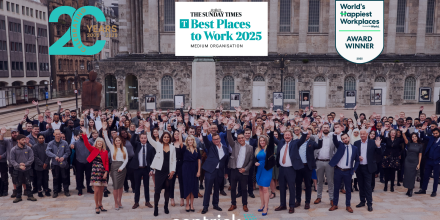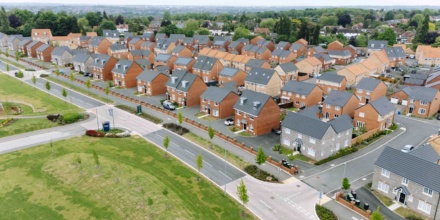The Build To Rent sector is evolving rapidly. With the pandemic morphing the purpose of the modern home, and COP26 encouraging the implementation of more considered Environmental, Social and Governance factors. The ever changing residential landscape and clear rental trends provide a fantastic opportunity for developers to capitalise and get ahead of these trends, producing high-quality living experiences on a considerable scale which cater both to an environmentally conscious future and the evolution of the hybrid working model. However, predicting the future of the rental market is not enough to create a sustainable, profitable build to rent development. In this piece, Centrick will be guiding you through the key things to consider when pricing Build To Rent developments to ensure that your long-term yield is worthwhile.
More and More People are Renting
It’s no surprise that evidence shows that the number of people renting in the UK is slowly increasing. We’re perhaps all familiar with the predictions that Renting will outweigh Purchase giving the lack of affordable purchase options and lending available. But it’s not just millennials or young people choosing or being forced into a long term rental scenario, according to Generation Rent, the number of families in rented properties has doubled since 2000, with BTR developers being tasked with the important mission of providing accommodation for this growing demographic of Single Family Housing. This is a direct effect of the increase in house prices, and subsequent unattainability of owning a property.
House Prices are Rising
With rental prices rising by 2.7% according to the ONS, it’s important to remain competitive in a market which openly looks to help tenants to become first time buyers. There are an abundance of incentives for tenants to make the leap into becoming home owners via shared ownership schemes and, for now, Help To Buy equity loans – BTR developers will of course be familiar with, and aware and competing to provide an alternative that secures long term tenancies. Developers that recognise not just the benefits of renting, such as the flexibility of short-term tenancies, ability to choose and of course location, transport and amenity links and innate ability to defer maintenance to the landlord. What’s more, house prices are soaring, according to Halifax, who reported that the average property price has peaked at £286,079 – this allows for BTR developers to press the advantage of renting, which is more financially feasible for many.
Value for Money
Build To Rent developments are a key opportunity to create stylish accommodation, brilliant living experiences and, of course, revenue at scale. However, it certainly has its challenges: the pandemic has shown tenants that home is far more than just a location – it is now the office, the gym, the classroom and the nursery for many. BTR developers must aim then to provide more evolved services in order to remain both competitive and provide value for money to their tenants if they are to win in the BTR race. For example, professional renters between the ages of 25 and 40 are particularly interested in having access to on-site gymnasiums, saunas and swimming pools.
Demographic Deep Dive
21-30
This audience is called Generation Rent for a good reason. With the entry price for a first property much higher than it was twenty years ago, it’s no surprise that the vast majority of 21-30 year olds are living in rental properties rather than buying their own home. This demographic tends to be focused on saving funds for their first property purchase, with many opting to live in shared rental accommodation to keep their living costs low and maximise their ability to save. In fact, reports show that the average age of co-living tenants is now over 28. This is likely down to the provision of communal facilities such as gardens and large shared kitchens in shared houses, allowing them to enjoy the benefits of a larger property without the hefty price tag. If you’re looking to appeal to this audience, keep cost at the forefront of your mind: accommodation that allows these tenants to keep costs down will appeal to this age range most.
Similarly, a somewhat European trend of younger generations not being overly concerned by the prospect of buying a property is on the rise. As younger people find their footing in their careers and relocate frequently for work, it’s becoming increasingly popular for those under 30 to have little to no aspirations to purchase a home outright, instead preferring the freedom and convenience of renting and short-term leasing. There is a sense of security in not having a mortgage: in the event of a significant life change (take the pandemic, for example) which jeopardises one’s income, having the ability to simply relocate to a less expensive property is an appealing prospect, and surely less hassle than re-mortgaging your property.
30-45
According to the Office for National Statistics only “half of people in their mid-30s to mid-40s had a mortgage in 2017, compared with two-thirds 20 years earlier”. With schemes such as Help to Buy set to end in October, we expect that the number of homeowners within this age range will continue to fall, meaning that more individuals between 30 and 45 will be renting. This demographic is more likely than the aforementioned 21 to 30 year old group to have established careers and children, thereby altering their wants and needs in a rental property. This age range is most likely to be concerned by the proximity of their home to key amenities such as their workplace, commuter links and their children’s schools. With the likelihood of this demographic also having more established careers and more disposable income, it is also more likely that these individuals and families may want a more luxury living experience. Amenities such as en-suite bathrooms, gymnasiums, cleaners and day-care facilities will surely go down well with this demographic.
46+
There is a definite gap in the market for developments targeted at older individuals, with Tom Scaife, Head of Senior Living at Knight Frank, noting that “there is a clear demand for rental homes for those aged 65+ in the market, however at this time there are only a handful of senior living BTR blocks up and running”. Akin to the previous demographic, those reaching middle age and over are becoming more and more likely to rent their homes into older age rather than purchase property outright according to the same ONS survey. Renting at an older age may also be on the rise due to increasing number of divorce later in life, with a different ONS survey explaining that many couples over 65 are now fragmenting, leaving the individuals to leave established family homes and rent on their own. These so-called ‘silver splicers’ are more likely to be long-term renters that are looking to settle into accommodation for the foreseeable future. Furthermore, according to the Knight Frank Tenant Survey of 2019, people of middle age or older are becoming more likely to rent so as to avoid the burden of owning a property. These individuals enjoy convenience and ease of living, with the appeal of build to rent developments being their ability to offer concierge services and maintenance repairs at ease and no additional cost.
It’s important to understand what is popular with tenants and what kind of tenants you wish to target with your BTR development, in order to determine what facilities will be valuable in your development and reap the financial benefits of longer tenancies, reduced void periods, and higher rent. An experienced BTR agency such as Centrick is able to assist developers in understanding how to navigate tenant demand and expectations so that you can optimise and future-proof your development.
Centrick are your local property experts, with decades of experience in helping clients develop the most sought-after Build To Rent developments. Our combination of asset management, residential sales and residential lettings experience allows us to understand the build to rent journey from its inception to its completion, enabling us to advise you at every stage of your build to rent journey. For more information on how Centrick can help you build a development that appeals to tenants, contact our BTR team using the form below.










